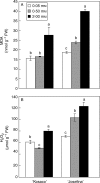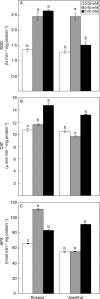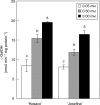Oxidative stress and antioxidants in tomato (Solanum lycopersicum) plants subjected to boron toxicity
- PMID: 17660516
- PMCID: PMC2749626
- DOI: 10.1093/aob/mcm156
Oxidative stress and antioxidants in tomato (Solanum lycopersicum) plants subjected to boron toxicity
Abstract
Background and aims: Boron (B) toxicity triggers the formation of reactive oxygen species in plant tissues. However, there is still a lack of knowledge as to how B toxicity affects the plant antioxidant defence system. It has been suggested that ascorbate could be important against B stress, although existing information is limited in this respect. The objective of this study was to analyse how ascorbate and some other components of the antioxidant network respond to B toxicity.
Methods: Two tomato (Solanum lycopersicum) cultivars ('Kosaco' and 'Josefina') were subjected to 0.05 (control), 0.5 and 2 mm B. The following were studied in leaves: dry weight; relative leaf growth rate; total and free B; H(2)O(2); malondialdehyde; ascorbate; glutathione; sugars; total non-enzymatic antioxidant activity, and the activity of superoxide dismutase, catalase, ascorbate peroxidase, monodehydroascorbate reductase, dehydroascorbate reductase, glutathione reductase, ascorbate oxidase and l-galactose dehydrogenase.
Key results: The B-toxicity treatments diminished growth and boosted the amount of B, malondialdehyde and H(2)O(2) in the leaves of the two cultivars, these trends being more pronounced in 'Josefina' than in 'Kosaco'. B toxicity increased ascorbate concentration in both cultivars and increased glutathione only in 'Kosaco'. Activities of antioxidant- and ascorbate-metabolizing enzymes were also induced.
Conclusions: High B concentration in the culture medium provokes oxidative damage in tomato leaves and induces a general increase in antioxidant enzyme activity. In particular, B toxicity increased ascorbate pool size. It also increased the activity of l-galactose dehydrogenase, an enzyme involved in ascorbate biosynthesis, and the activity of enzymes of the Halliwell-Asada cycle. This work therefore provides a starting point towards a better understanding of the role of ascorbate in the plant response against B stress.
Figures




Similar articles
-
Gibberellic acid-induced generation of hydrogen sulfide alleviates boron toxicity in tomato (Solanum lycopersicum L.) plants.Plant Physiol Biochem. 2020 Aug;153:53-63. doi: 10.1016/j.plaphy.2020.04.038. Epub 2020 May 1. Plant Physiol Biochem. 2020. PMID: 32474386
-
Exogenous Melatonin Counteracts NaCl-Induced Damage by Regulating the Antioxidant System, Proline and Carbohydrates Metabolism in Tomato Seedlings.Int J Mol Sci. 2019 Jan 16;20(2):353. doi: 10.3390/ijms20020353. Int J Mol Sci. 2019. PMID: 30654468 Free PMC article.
-
The effect of Botrytis cinerea infection on the antioxidant profile of mitochondria from tomato leaves.J Exp Bot. 2004 Mar;55(397):605-12. doi: 10.1093/jxb/erh076. Epub 2004 Feb 13. J Exp Bot. 2004. PMID: 14966215
-
Hydrogen peroxide, ascorbate, and glutathione: building the Foyer-Halliwell-Asada pathway.Planta. 2025 May 8;261(6):132. doi: 10.1007/s00425-025-04702-4. Planta. 2025. PMID: 40338355 Free PMC article. Review.
-
Ascorbic acid metabolism and functions: A comparison of plants and mammals.Free Radic Biol Med. 2018 Jul;122:116-129. doi: 10.1016/j.freeradbiomed.2018.03.033. Epub 2018 Mar 20. Free Radic Biol Med. 2018. PMID: 29567393 Free PMC article. Review.
Cited by
-
How Plants Handle Trivalent (+3) Elements.Int J Mol Sci. 2019 Aug 16;20(16):3984. doi: 10.3390/ijms20163984. Int J Mol Sci. 2019. PMID: 31426275 Free PMC article. Review.
-
Boron excess affects photosynthesis and antioxidant apparatus of greenhouse Cucurbita pepo and Cucumis sativus.J Plant Res. 2013 Nov;126(6):775-86. doi: 10.1007/s10265-013-0575-1. Epub 2013 Jun 19. J Plant Res. 2013. PMID: 23779070
-
A functional phylogenomic view of the seed plants.PLoS Genet. 2011 Dec;7(12):e1002411. doi: 10.1371/journal.pgen.1002411. Epub 2011 Dec 15. PLoS Genet. 2011. PMID: 22194700 Free PMC article.
-
Methyl jasmonate counteracts boron toxicity by preventing oxidative stress and regulating antioxidant enzyme activities and artemisinin biosynthesis in Artemisia annua L.Protoplasma. 2011 Jul;248(3):601-12. doi: 10.1007/s00709-010-0218-5. Epub 2010 Oct 19. Protoplasma. 2011. PMID: 20957501
-
Variability in Physiological Traits Reveals Boron Toxicity Tolerance in Aegilops Species.Front Plant Sci. 2021 Oct 29;12:736614. doi: 10.3389/fpls.2021.736614. eCollection 2021. Front Plant Sci. 2021. PMID: 34777419 Free PMC article.
References
-
- Bellaloui N, Brown PH. Cultivar differences in boron uptake and distribution in celery (Apium graveolens), tomato (Lycopersicon esculentum) and wheat (Triticum aestivum) Plant and Soil. 1998;198:153–158.
-
- Benzie IEF, Strain JJ. The ferric reducing ability of plasma (FRAP) as a measure of antioxidant power: the FRAP assay. Analytical Biochemistry. 1996;239:70–76. - PubMed
-
- Beyer WF, Fridovitch I. Assaying for superoxide dismutase activity: some large consequences of minor changes in conditions. Analytical Biochemistry. 1987;161:559–566. - PubMed
-
- Blevins DG, Lukaszewski KM. Boron in plant structure and function. Annual Review of Plant Physiology and Plant Molecular Biology. 1998;49:481–500. - PubMed
Publication types
MeSH terms
Substances
LinkOut - more resources
Full Text Sources
Medical

